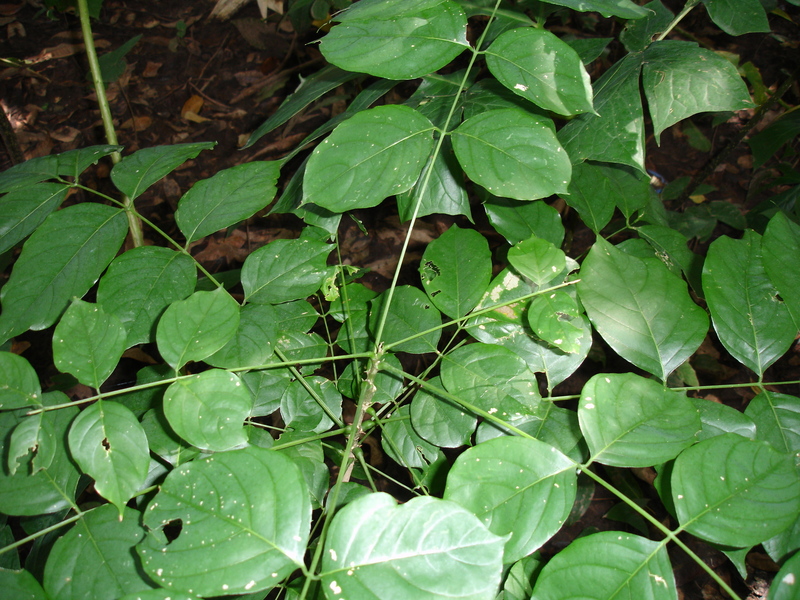Lonchocarpus cyanescens

|
|
Lonchocarpus cyanescens Common Names: West African Indigo, Yoruba Indigo, Gara Scientific
Classification Kingdom: Plantae Phylum: Tracheophyta Class: Magnoliopsida Order: Fabales Family: Fabaceae Genus: Lonchocarpus Species: L. cyanescens Synonyms: Lonchocarpus cyaneus (Schumach. & Thonn.) Benth., Macrolobium cyanescens Schumach. & Thonn., Philenoptera cyanescens (Schumach. & Thonn.) Roberty Morphological Description Lonchocarpus cyanescens is a deciduous shrub or small tree, typically growing 6–15 m
tall, native to tropical Africa. Its key features include: · Habit: Shrub or small tree with a straight trunk and a spreading,
rounded canopy. · Stem: Bark greyish-brown, smooth when young, becoming fissured
with age; branches drooping. · Leaves: Alternate, pinnate, 15–25 cm long, with 5–9 ovate leaflets,
4–10 cm long, dark green, glabrous above, slightly pubescent below. · Flowers: Small, white to pale purple, 8–12 mm long, in dense axillary
or terminal racemes; fragrant during the rainy season (Burkill, 1995). · Fruit: Flat, oblong pods, 5–10 cm long, 1–2 cm wide, brown when
mature, containing 1–5 seeds. Distribution and Habitat Lonchocarpus cyanescens is widespread across tropical West Africa, including: · Countries: Cameroon, Central African Republic, Democratic Republic of
the Congo, Equatorial Guinea, Gabon, Ghana, Guinea, Ivory Coast, Liberia,
Nigeria, Sierra Leone, Togo. It thrives in coastal
forests, riverine thickets, and wooded savannahs at elevations up to 400 m. It
prefers well-drained, sandy-loam soils (pH 5.5–7.0) and tolerates seasonal
flooding (Burkill, 1995). Ethnopharmacology Lonchocarpus cyanescens, also known as Philenoptera cyanescens, is a medicinal plant native to West
Africa, traditionally utilized for various therapeutic purposes. Its leaves and
roots are employed in treating conditions such as bone pain, yaws, diabetes
mellitus, venereal diseases, and stomach aches. The bark is used to manage body
pains, arthritis, rheumatism, and parasitic infections. Phytochemical analyses
have identified compounds like alkaloids, flavonoids, saponins, and tannins in
the plant. Pharmacological studies have demonstrated its anti-inflammatory,
anti-arthritic, antimicrobial, and antipsychotic properties, supporting its
traditional medicinal applications. · Antipsychotic: Leaf decoctions in Nigeria treat psychosis. Sonibare et al.
(2012) found aqueous and ethanolic extracts (25–400 mg/kg) suppressed
amphetamine-induced stereotypy in rats by 50%, linked to flavonoids like
quercetin and kaempferol. · Anti-inflammatory/Analgesic: Roots in Ghana treat arthritis. · Anthelmintic: Leaf sap in Benin combats intestinal worms. Baumgärtel et
al. (2023) note its use for dysentery and parasitic infections. · Antimicrobial: Leaf poultices in Sierra Leone treat ulcers. Sonibare et al.
(2014) confirmed alkaloids and flavonoids inhibit Staphylococcus aureus (MIC 50 μg/ml). · Postpartum Care: Root decoctions in Nigeria aid
post-childbirth recovery. Moronkola et al. (2013) suggest saponins and tannins
support uterine health. · Laxative: Leaves in Guinea relieve constipation, supported by saponin
content (Sonibare et al., 2014). Phytochemicals include
flavonoids (quercetin, kaempferol), triterpenoids (lupeol), alkaloids,
saponins, and indican, contributing to its medicinal versatility (Moronkola et
al., 2013). ⚠ Toxicity Profile: No significant hepatotoxicity was observed in rats at aqueous leaf
extract doses up to 5,000 mg/kg over 28 days (Iyoha & Aisuhuehien, 2023).
However, high doses may cause mild gastrointestinal upset due to saponins, and
leaf sap may irritate skin in sensitive individuals (Baumgärtel et al., 2023). Additional Uses · Dye Production: Leaves yield indican, processed into
indigo dye for textiles (e.g., Yoruba adire cloth) since the 11th century
(Cardon & Jansen, 2005). · Timber: Hard, durable wood used for carpentry and construction in
rural communities (Burkill, 1995). · Ecological: Enhances soil fertility via nitrogen fixation, aiding
agroforestry (Achigan-Dako, 2009). References
External Links More Pictures |
|
| Compounds of Lonchocarpus cyanescens | |
| References |